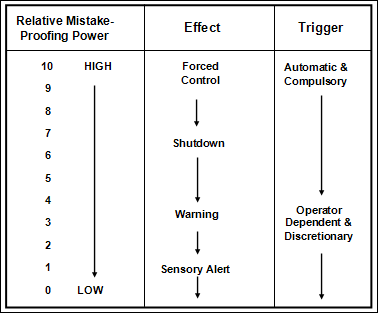Resource Centers
Approaches to Mistake-Proofing
There are four different effects from mistake-proofing:
- Forced Control
- Shutdown
- Warning
- Sensory Alert
Any of the effects can have a prevention or detection outcome.
- The 4 effects coupled with 2 outcomes yield 8 different potential types of solutions.
The 8 types of solutions have different levels of mistake-proofing power.
- The first choice, whenever possible, is to prevent the mistake from being made using a mistake-proofing solution with a forced-control effect.
- The second choice depends on the situation:
- If the cost of shutting down the line isn’t too great, then use a shutdown-prevention mistake-proofing solution to prevent the mistake from occurring.
- If however, it is more expensive to shut down the process than to detect a mistake and prevent it from getting out to the customer, then try a forced control-detection solution.
- The third choice would usually be a shutdown-detection solution.
Warning and sensory alert effects are less powerful.
- The distinction between an automatic trigger (for forced control and shutdown) and an operator dependent trigger (for warning and sensory alert) makes solutions with forced control and shutdown effects more powerful.
Mistake-proofing solutions can be assigned a relative power rating based on the effect used.

The trigger (for initiating the solution) is a major differentiator.
- Forced control and shutdown effects both have automatic triggers.
- Warning and sensory alert effects have triggers that depend on the operator to notice and respond to them.


